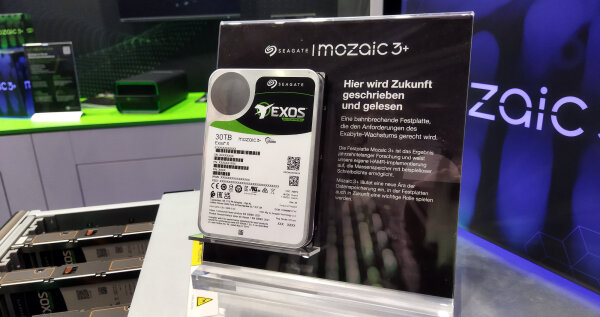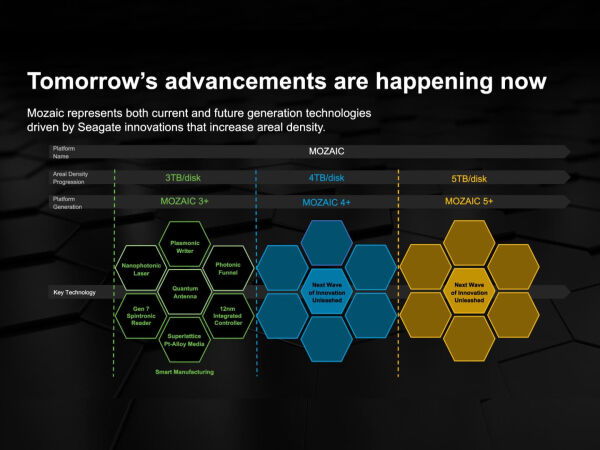[19:11 Mon,23.December 2024 by Thomas Richter] |
After many delays, Seagate has finally started mass production of its first hard drive series using HAMR technology to enable a capacity of up to 32 TB. This storage density is achieved through heat-assisted magnetic recording (HAMR).  New Exos M hard drive with HAMR technology Traditional hard drives are still cheaper than SSDsAt current prices of 15 euros per TB, hard drives still store large amounts of data significantly cheaper than solid-state SSDs, whose TB prices are about 3 times higher. While SSDs are also significantly faster, besides classic archiving there are numerous other applications where a lower transfer rate of approx. 200 MB/s is perfectly sufficient. Such data rates can be perfectly sufficient even for simple, rather linear editing projects, provided that a hard drive is freshly filled with material at the beginning of the project and is therefore not fragmented. Higher storage density through HAMRFor almost 20 years, the technology of heat-assisted magnetic recording (HAMR) has been developed, which solves the problem of the increasing instability of the smallest magnetic storage unit with increasing miniaturization by using more stable materials. These materials are heated by a laser before an intended change in magnetization (i.e., a storage process). When writing using HAMR, the area to be written is briefly heated to a temperature of 450 degrees using an 800-nanometer laser to reduce the field strength at that point and to be able to write a bit precisely. To withstand this heat, platters made of glass-ceramic are used instead of the usual aluminum alloy. A data track can thus currently be about 40 nanometers narrow. The HAMR-based technology (Mozaic 3+) developed by Seagate www.seagate.com/innovation/mozaic/ allows a data density of 3+ TB per platter. The 3.5" Exos M 32 TB uses 10 of these platters to achieve its large storage volume.  Seagate&s Mozaic technology Through further optimization of this technology, Seagate expects even greater capacity leaps in the future than in recent years. Seagate aims to achieve a data density of 4 TB/platter with Mozaic 4+ in 18-24 months, and from 2027 onwards, capacities of 5 TB should be possible (thanks to Mozaic 5+), which would correspond to a storage capacity of 50 TB (using 10 platters). HAMR - the delayed technologyBut why did it take so long for HAMR to finally become market-ready? The new technology was plagued by delays: Seagate originally expected to produce 60 TB HAMR hard drives by 2022, but then missed these (and other) targets several times. Even in 2022, Seagate promised 40+ TB hard drives two years later - but only now are HAMR hard drives actually going into mass production - with "only" 32 TB. The unforeseen problems were caused, among other things, by the high complexity of the new HAMR technology, which required new media (platters), read and write heads with integrated laser, controller, actuators and other components, all of which had to be newly developed.  AvailabilityThe Seagate Exos M hard drives with a capacity of 30 and 32 TB will be Competitor Western Digital, however, was slightly ahead of Seagate and had already launched a 32 TB hard drive in October with the Ultrastar DC HC690 www.slashcam.de/news/single/Western-Digital-Ultrastar-DC-HC690-mit-32-TB---Vie-18889.html - but this uses further developed traditional technology, namely the combination of ePMR (energy-assisted Perpendicular Magnetic Recording) with UltraSMR (Shingled Magnetic Recording) and the fact that the HC690 is the first hard drive to work with 11 individual platters (the maximum was previously 10). And another competitor is not inactive either, because besides Seagate, Toshiba is also developing new hard drives that use HAMR and MAMR (microwave-assisted magnetic recording). deutsche Version dieser Seite: Seagate Exos M 32 TB: Neue HAMR-Technologie ermöglicht Speicherrekord |




